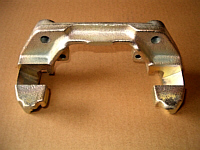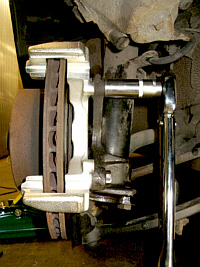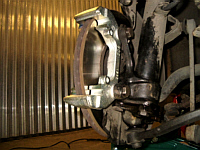Overview
- The Problem
- Tools, Skills And Parts
- Preparations
- Removing Brake Pad Carrier
- Mounting Brake Pad Carrier
- Tightening Torques
The Problem
The reason behind replacing a brake pad carrier can be several.
But in this case it was due to a broken brake caliper guide bolt
where a small part of the bolt remained in the brake pad carrier
(on which the brake caliper is mounted on). A quick and easy solution
is to simply replace the entire brake pad carrier.
Tools, Skills And Parts
The job is pretty straightforward and does not include any
special tools.
Difficulty Level

The following tools are required for this particular work (tools marked with
green checkmark are optional).
 | Jack | |
 | Jack pad liners | |
 | Jack stand | |
 | Screwdriver (flat-blade, 3.5 mm) |
 | Wheel nut wrench (17 mm) | |
 | Tire lever (small) | |
 | Ratchet wrench (15 cm, small) |
 | Socket extension bar (10 cm) |
 | 7 mm Allen key socket | |
 | 19 mm 6-point socket | |
 | Torque wrench |
 | Disc brake pad spreader | |
 | Brass brush |
 | CRC Copper paste | |
 | CRC 5-56 | |
 | CRC Bräkleen | |
The following spare parts are required for this particular work. Note
that the BMW internal numbers are intended for a BMW 535i E34 -89.
 | brake pad carrier | 34 11 1 160 366 |
Preparations
The brake pad carrier is mounted with two large 19 mm hex head screws directly on the front
strut assembly. The brake caliper is then mounted onto this brake pad carrier using two 7 mm Allen
key guiding bolts. To ease the work of loosening the two 19 mm hex head screws it is recommended
to soak down the area around these two screws with CRC 5-56 or similar and let it stay and penetrate
over the night. See the picture below for the location of the two screws.

The front right strut assembly, brake pad carrier and the brake disc. Note that the brake caliper
has been dismounted and moved out of the way. The 19 mm hex head srews holding the brake pad
carrier are marked in the picture.
Removing Brake Pad Carrier
Start by jacking up the car, remove the wheel and the brake caliper. This is described
in detail in the brake pad replacement job. It is now time to try to loose the two screws
holding the brake pad carrier. It may require quite a lot of force to loosen these screws
but with the right tools it shouldn't be any problem. It is strongly recommended to only
and only use 6-point sockets (or wrenches). Using 12-points sockets (or wrenches) will
only transform the hex shape into round shape, especially when the bolts and screws are
sitting tight as it can be in this case.
After the screws have been loosened, remove them completely together with the old
brake pad carrier. The view at the front strut assembly should now look like the
picture below.

The front right strut assembly with the brake caliper and brake pad carrier removed.
|
Mounting Brake Pad Carrier
It is now time to unpack your absolutely fresh brake pad carrier. Below is a series
of pictures illustrating how this piece looks like when it is completely new.

An absolutely fresh brake pad carrier.

An absolutely fresh brake pad carrier.

An absolutely fresh brake pad carrier.
Start by cleaning the two large 19 mm hex head screws using brass brush and cotton waste
for example. Add a thin thin coat of copper paste on the threads. Mount the new brake pad
carrier with the two cleaned screws and use a torque wrench as the last step. See the picture
below for an example and the table at the end of this article for torques.

The upper 19 mm hex head screw holding the brake pad carrier tightened with a torque wrench.
The job is almost finished now. Optionally clean the brake disc with CRC Bräkleen or
similar to remove oil, grease and deposits. The remainder of the installation is the reverse
of removal.

The new brake pad carrier mounted looking shiny and new!
Tightening Torques
| Brake caliper to brake pad carrier (guide bolt) | 35 Nm (26 ft-lb) |
| Brake pad carrier to front strut assembly | 110 Nm (81 ft-lb) |
| Road wheel to hub | 100±10 Nm (74±7 ft-lb) |
|

